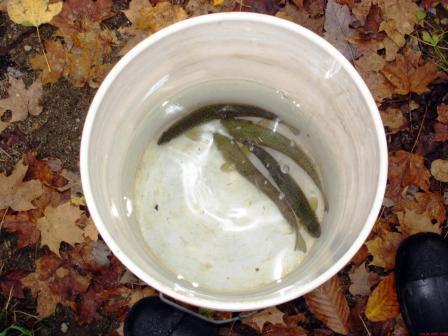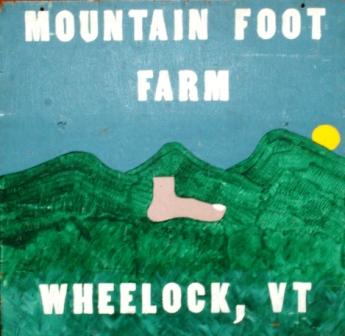Navigation |
Pond Stocking FAQs |
Photo |
||||||||||
Will trout live in my pond?Trout need cold (or at least cool), clean, high quality water with plenty of oxygen. They need either sufficient flow or sufficient volume of water to maintain the quality of the water. Your pond needs to maintain a temperature of at most 65 degrees F at the bottom of the pond in mid summer. Your pond needs sufficient depth so that in winter there is adequate oxygen in the water under the ice to keep the trout alive. In general, trout ponds in this area need about 8 feet of depth and a sufficient source of cold water (such as natural springs) to provide the conditions that trout need. Shallower ponds usually heat up too much in the summer and do not have sufficient volume under the ice to allow a reasonable survival rate of stocked trout. There are exceptions. I know of a very small pond that maintains trout very well even though it is only about 3 feet deep, but it has a very high flow rate of cold water so that it never overheats in summer and in fact never ices over in winter. What are the trout species?There are three species of trout available for pond stocking in Vermont. Brook trout (sometimes called Square Tails or Speckled Trout) are the native species of trout in eastern North America. They prefer the coldest and cleanest water. Rainbow trout are originally from western North America but have become naturalized to this area. They are the fastest growing and prefer slightly warmer water than brook trout. Brown trout are originally from Europe, but have become naturalized to this area. They can survive in warmer and murkier water and are the hardest to catch by angling . How many trout to stock?How many trout your pond will support depends on the pond and on your management of the pond. If you intend to have the trout survive off the natural feed found in a pond with no or minimal management from you, the limiting factor on the number of trout is usually the amount of feed that your pond can provide naturally. If you are providing supplemental feed for the trout, the limiting factor on the number of trout usually has to do with management factors necessary to maintain adequate water quality to maintain the health of the trout. For a pond with no or minimal management (little or no supplemental feeding), a general rule of thumb is that a mature pond (a mature pond is defined as a pond at least three years old) can support about 100 eight inch trout per quarter acre of surface area. This is only a very rough rule of thumb - the water chemistry, surrounding soil characteristics and other features of your pond can affect its trout carrying capacity significantly. Note also that a pond that can maintain 100 eight inch trout could support many more smaller trout, but fewer larger trout. If you want to provide supplemental feed to the trout, the number of trout in a pond can be increased significantly. Increased by how much depends upon the particular characteristics of your pond and your management decisions. For example, one pond I have managed is about one quarter acre in area, is totally spring fed, is about eight feet deep, and has about five gallons per minute flow rate leaving the pond in mid summer. During the spring, summer and fall, with just supplemental once daily feeding, four or five times the above mentioned rule of thumb carrying capacity can easily be maintained. The trout population of the pond would be reduced in winter so as not to have to feed or manage them during the iced in season. The number of trout raised in that pond could be increased further by increasing the flow rate of water and by supplemental aeration. What size of trout should be stocked?This depends upon your preferences and your plans. Smaller trout cost less, but take longer to reach large size. Under optimal conditions, a rainbow trout can grow as much as one inch per month, but usually much less than that. If your trout grow a total of six inches per year, they are growing very well. It is not recommended to stock trout smaller than 3 inches in length, because their mortality rate in a pond is very high at that stage of life. Stocking a pond with different sized trout can also result in losses of the smaller trout. Trout are carnivores and will eat other fish (including other trout) if the other fish are small enough. The rule of thumb in a trout hatchery situation (where fish densities are relatively high and there is no place to hide for the smaller trout) is to never have a trout less than half the length of another trout in the same tank. In a simple small pond, that hatchery rule of thumb should probably be followed. The larger the pond and the more places in the pond that small fish can hide, then the more that the hatchery rule of thumb can be relaxed. What do trout eat?Trout are basically carnivores. That is, they eat animals, not plants. Trout consume a wide variety of aquatic insects, flying insects, worms, frogs, frog eggs, smaller fish and other under water animal life forms. They can also be fed commercially prepared fish food or trout feed. Note that not all fish feed is trout feed. Some fish feed is a general purpose supplemental feed for fish (not specifically for trout). The advantage of general purpose fish feed over trout feed is that it is somewhat less expensive, and is all right to use as a small portion of the total trout diet. The disadvantage of general purpose fish feed in comparison with trout feed is that if it is too large a portion of a trout's diet then the eating quality of the harvested trout will suffer and ultimately the health of the trout can suffer if very large portions of their diet is general purpose fish feed. Using trout feed avoids these problems, but costs more. I use Zeigler brand trout feed. What eats trout?Besides us humans, there are many wild animals that prey upon trout, including: raccoons, blue herons, mink, and otters. How many of your pond stocked trout could be lost to predation can not be predicted. When to stock trout?Trout are cold blooded animals. That is, their body temperature is just about the same as the water temperature they are swimming in. Therefore they are very sensitive to rapid increases in water temperature. For example, if trout are taken from a trout farm's holding tank which is at a temperature of 46 degrees F and stocked into a pond that is at a temperature of 65 degrees F, then a significant portion of the trout so stocked will probably die within two days of that stressful (for the trout) stocking. To avoid such occurrences, most pond stocking is done when pond temperatures are close to fish farm holding tank temperatures. It depends on the weather, but usually the prime pond stocking times in Vermont are May in the spring and October in fall. You can certainly schedule the pond stocking in advance of the actual stocking date and that way you have the best chance to receive what you want if any are in short supply. Where do I get trout for pond stocking?There are several private trout farms within Vermont that are licensed by the state. One of these is Mountain Foot Farm. Mountain Foot Farm raises and sells brook, brown and rainbow trout. This farm has been licensed by the Vermont Fish & Wildlife Department for the propagation of trout since 1991. The Vermont Fish & Wildlife Department also performs an annual fish health inspection (as a condition of the license) under which Mountain Foot Farm has received class A status: "No listed fish pathogens found". Mountain Foot Farm only stocks ponds within the state of Vermont. How much does it cost to stock a pond?There is a per fish price that depends on the size of the trout. The current (as of 2022) per fish prices:
There is also a delivery charge which varies with the distance from the farm in Wheelock, VT. More Information?This document is just a brief introduction to the subject of raising trout in ponds. I would be happy to discuss the subject further or talk about the particulars of your pond. |
 |
